Do you have a piano gifted from your great-grandfather to your late grandpa lying around the house? Well, if that’s a yes – or you happen to have any piano from the 1900s, you have a goldmine under possession.
The exact and actual value of your antique piano depends on its brand, type, condition, and a few other factors. But generally, antique pianos sell for $2500 or more. If you have a 100+ years old piano that’s maintained well, it could even be worth $5000 or more.
In this antique piano value guide, we’ll share everything you need to know to rightfully weigh the value of an antique piano. Whether you’re buying one or selling, you’ll find the details enclosed in this post super useful.
Let’s get started!
Table of Contents
Types of Antique Piano
Generally, we determine the type of piano by its construction and style. In the present day, the following are the four major types of pianos:
Grand Pianos
Upright Pianos
Electric Pianos
Hybrid Pianos
All four of these differ from one another in terms of size, sound production, tonal color, and sonic performance. You can explore these differences in complete detail here in this guide about All 11 Types of Pianos [Uses, Features, and more!]
Similar to the present-day division, there were four key types of pianos produced back in the 1800s and 1900s. These were:
Square Grand Pianos (discontinued)
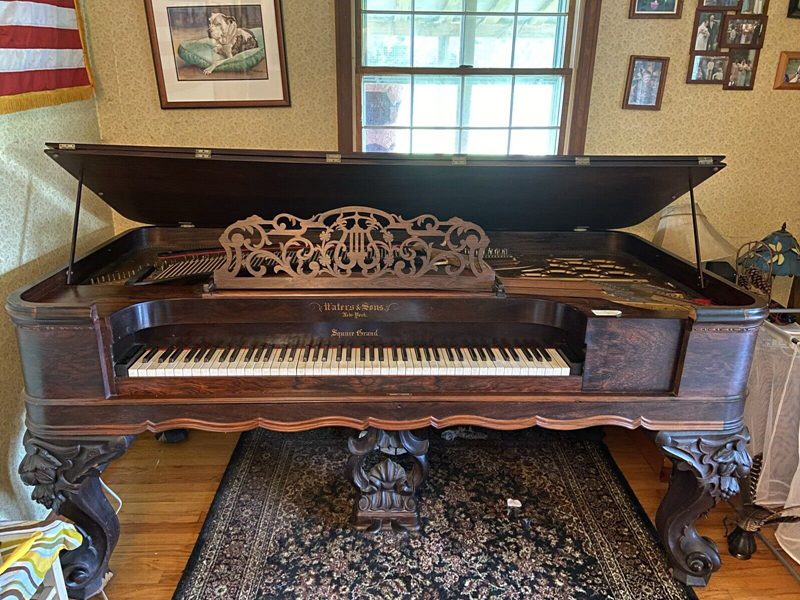
Introduced in the mid-18th century, square grand pianos were huge musical instruments usually found in music-loving homes. Since these were large, they were difficult to move and maintain. However, they were popular in the old times because of the ongoing trends, aesthetics, and impressive sound production.
Its large size and consequent heavy pricing became a con for the musical instrument. And soon, it got overpowered by other compact and economical pianos types, such as grand pianos.
Not many companies manufacture square grand pianos today. And they are also difficult to restore because there are rarely any piano tuners who know how to fix these.
For that very reason, square grand pianos are the most antique pianos but they do not hold much monetary value. Most of them do not produce any fine tunes anymore.
Grand Pianos
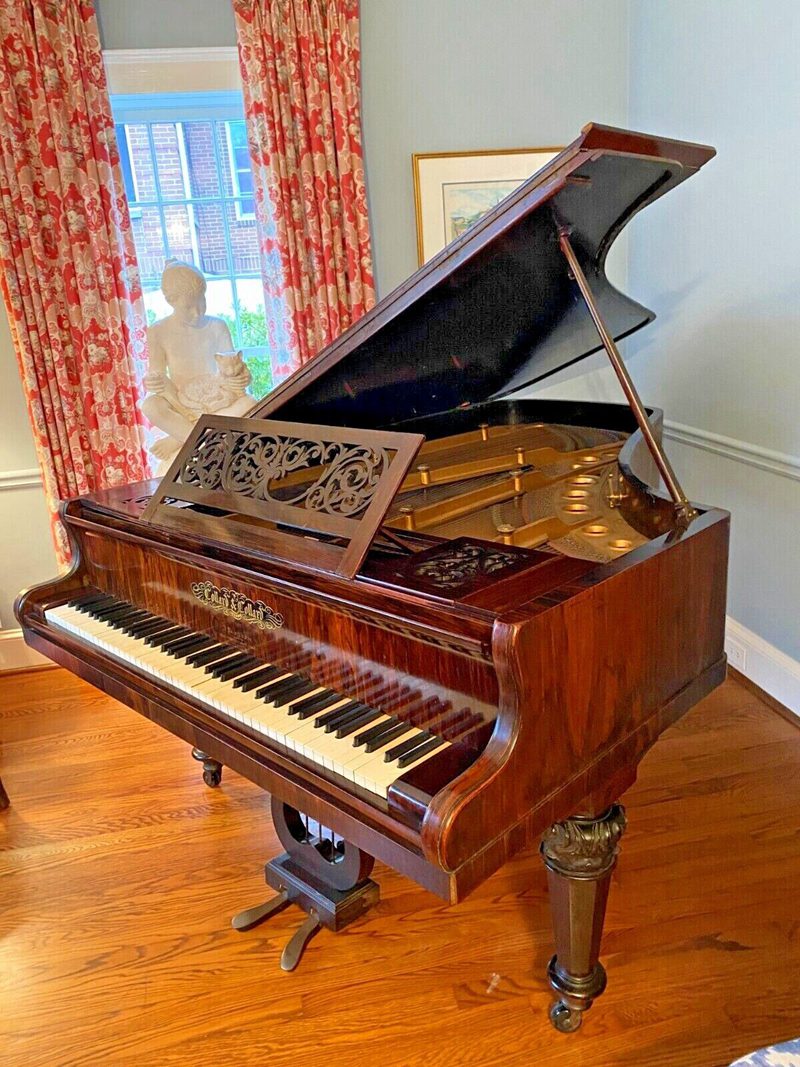
Grand pianos have different engineering and sound-producing mechanisms. The majority of the most expensive antique pianos today are of this type.
And that’s primarily because you can still find companies producing grand pianos. Hence, the older variants can still be fixed and restored.
The three common types of grand pianos (in old and new variants) are as follows:
- Baby grand piano (5 feet/1.5m)
- Parlor grand piano (7 feet/2.2m)
- Concert grand piano (10 feet/3m)
Upright Pianos
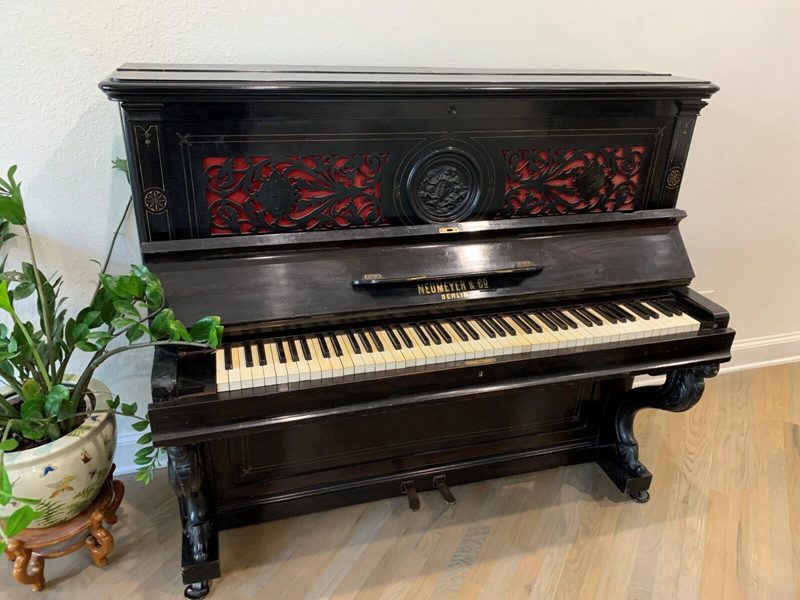
Upright pianos are the ones you can fit in the corner of your house. They have a cuboidal structure.
In comparison to grand pianos, upright pianos are compact and less expensive. For that very reason, they are most popular amongst students and improving learners.
These pianos do not have an impressive dynamic range like grand pianos, meaning their loudness and softness is much limited.
Since upright pianos are not as loud as grand pianos and they emit sound from the back, they are not suited for professional use. Plus, when placed against a wall, it lowers the volume of overall sound produced even further.
With that said, the first-ever upright piano was not welcomed by many because of its poor sound production and odd engineering. It was introduced in the year 1800.
However, by 1826, the upright piano had a much better reputation and demand in the market as antique upright piano brands worked hard to improve its performance. Owing to this rise in popularity, there are plentiful valuable antique upright pianos available today.
Mirror Pianos
A lot of people get confused when it comes to mirror pianos. And that’s because mirror piano is a type of piano and a piano playing technique.
The type of piano that we recognize as mirror piano looks like this:
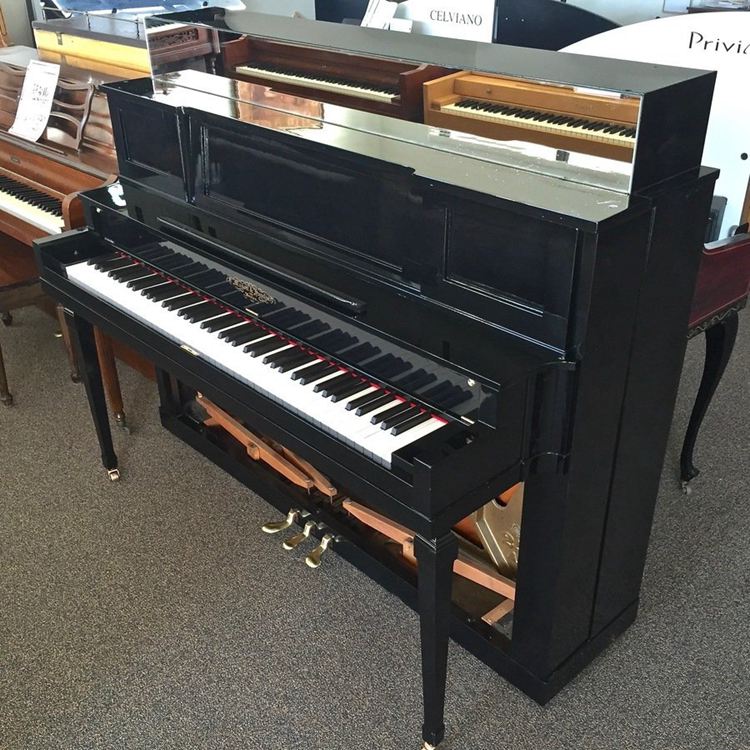
It is the same as an upright piano but with a mirror panel at the top. The mirror part of the piano increases its value by a few hundred dollars but not much. This unique variant emerged during WWII and gained much popularity because of its aesthetics.
As for the mirror piano playing technique, we suggest you watch the video what is a mirror piano? to learn more about it.
Identifying the Serial Numbers of Antique Piano
Be it an old piano or a new piano. It always comes with a serial number. The serial number is more like a birth certificate for the piano and the key to antique piano identification.
It can help you figure out the following three things about your piano:
- Manufacturing year of the piano
- Age of the piano
- Production details (manufacturing company, manufacturing processes, etc.)
Usually, a piano’s serial number has about 5-7 digits. It looks like this:
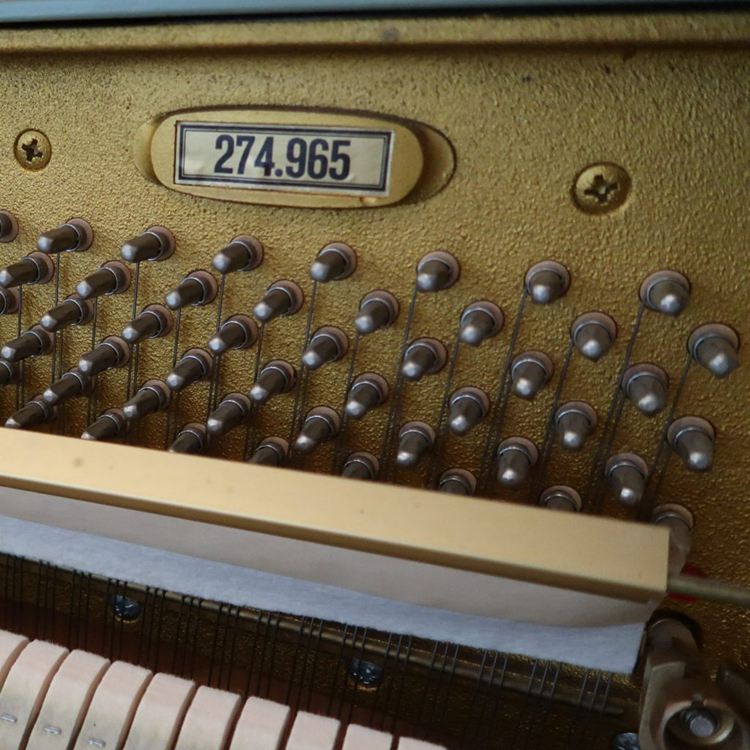
There may be more or less than 5-7 digits and the serial number may include alphabets. You can locate the serial number on a piano body in the following places:
- Piano’s cast-iron plate (left, right, or middle)
- Under the lid (extreme right or extreme left)
- Back of the piano (at the top)
On newer pianos, these serial numbers may even be located on the keys or the hammers. So, for pianos as old as 25 years or less, you can look for the serial numbers on keys and hammers too. Also, it may be difficult to locate the serial number on a piano manufactured in 1850 or earlier.
Assessing Antique Piano Value
Generally, a piano loses value with age. That’s because its structure starts to weaken, and the sound-producing mechanism inside begins losing its efficiency.
So, the older the piano, the lesser its monetary value will be. However, if it’s a limited edition or comes from a high-end brand, there’s a chance it could have an exceptional worth.
There’s also a way to increase the monetary value of an antique piano. It’s called restoration. You’ll have to spend a few bucks fixing its parts. But once done, you can sell it further for 5x your investments.
With that said, below we’ll be sharing the three prime factors that affect an antique piano’s value. And further below, you’ll find how you can maximize an antique piano’s monetary worth.
Age of Antique Piano
As mentioned earlier, older pianos are not worth much. But to truly understand this, you need to know how aging works in pianos.
Cars aged 45 years or older are considered antiques. Along the same lines, Barbie dreamhouses aged 20 years or older are considered antiques.
But when it comes to pianos, they have to be at least 100 years older to classify as antique. 50-year-old pianos classify as vintage or relatively modern.
However, 100+ years old functional pianos are a rarity. Most of them have either lost their body or sound-producing capability.
So, technically that means a truly antique piano has zero monetary value unless it is associated with a historical occurrence or personality. Or perhaps, it comes from a premium brand.
For that very reason, you will see several sources referring to 40-year-old pianos as antique pianos. It doesn’t make these pianos genuinely antique but helps with marketing the product.
Type of Piano
Above, we’ve shared a detailed breakdown of the types of antique pianos. It is noteworthy that a piano’s type also impacts its price significantly.
For example, a grand piano from 1880-1900 will have the following values based on its condition:
- Poor condition: $1.2k – $3k
- Good condition: $3.5k – $8k
- Restored: $28k – $55k
On the contrary, an upright piano from 1880-1900 will cost as follows:
- Poor condition: $300 – $1k
- Good condition: $1.6k – $6.5k
- Restored: $17k – $24k
As you can see, there’s a drastic difference between the prices even though both pianos belong to the same era.
Brands of Antique Piano
The manufacturing brand of a piano determines its monetary value and market positioning. If the brand is established well, the piano could be worth thousands. On the flip side, a piano from an unknown brand could be worth a few hundred only.
With that said, here’s a the list of most widely known antique piano brands:
- Broadwood
- Erard
- Chickering
- Bosendorfer
- Hallet & Davis
- Marshall & Wendall
- Vose & sons
- Bechstein
- Becker
- Knabe
- Bluthner
- Mason & Hamlin
- Kimball
- Story & Clark
- Baldwin
- Henry F.Miller
- Everett
- Bush & Gerts
- Yamaha
- Lester
- Apollo
- Bush & Lane
- Cable Nelson
- American
More brands manufactured and sold pianos during the 1800s – 1900s. But these were the most prominent names.
Some of these old piano brands are still alive and operating today, while some have closed down. Pianos from brands that have closed down have a higher value, especially if the brand was known for producing top-notch or expensive products. But those that come from lesser-known names hardly have any value.
On that note, here’s a quick glimpse of how the brand affects the price of a piano.
For a piano from a premium brand like Steinway & Sons, the pricing depreciates in the following ways:
- 5-10 years: $60k – $90k
- 10-20 years: $45k – $70k
- 20-30 years: $40k – $60k
- 40+ years: $1k – $15k
For moderately-priced brands like Yamaha and Kawai, the antique piano prices are as follows:
- 10-20 years: $2k – $20k
- 20-30 years: $5k or less
- 30+ years: $400 or less
Old or antique pianos that come from companies that no longer exist can be priced up to $5000. In this case, the condition factor becomes the primary price-determining factor.
Condition of Your Antique Piano
The condition of an antique piano impacts its pricing quite a lot. In some cases, it is the only value-determining factor.
For example, an old piano can have all the best attributes. It could be a 75-year-old grand piano from the best piano-making company but still cost $500 due to the scratches, dents, and visible damages on its body.
Here’s how you can evaluate the condition and consequent worth of your old piano:
Mint condition
If an antique piano is in mint condition, it is probably restored. Restoration basically refers to the process of rebuilding the insides of the piano and refining its exterior body. As a result of the restoration, it looks and works like a new piano.
Excellent
An antique piano that’s genuinely cared for and well-maintained usually appears to be in excellent or almost mint condition. It means that you can tell it’s old but not overused. It doesn’t have any scratches or blemishes and works perfectly well.
Good condition
An antique piano in a good condition works fairly well. However, its body may have a few scratches or blemishes. Or the body may be dirty. But there are no major mechanical problems with the piano.
Fair/okay condition
A fair-condition piano will play okay tunes. It will not give you the most melodious output. And that’s because it has a mechanical defect.
The body of an okay-condition antique piano may have visible dents, damages, scratches, and blemishes. It may even have a minor broken piece (such as a key). The sight of this piano tells that it needs professional repair.
Poor Condition
An antique or vintage piano is not worth buying if it is in a poor condition. Such a piano would fail to produce sound and the exterior would be in an awful condition. It’s not a good idea to buy it even with the intent of restoration. That’s because you’ll have to invest heavy amounts.
Takeaway
By the rule of thumb, an antique piano in mint condition possesses the highest possible value, while an antique piano in good or okay condition has a much-depreciated value.
Buying and Selling Antique Piano
Now that you know all about antique piano value, let’s talk about how you can practically implement your knowledge.
Selling an Antique Piano
First, let’s inspect the selling aspect of antique pianos. By far, selling an antique piano for a rightful price is a very tough job.
Almost every buyer would want to put your piano down and win a deal that saves them some money. You can tackle this by choosing the right marketplace.
Your goal is to make money with the antique piano. So, before you put your piano forward for sale, make sure you know its specifics. These specifics include the serial number, mechanical condition, external conditions, associated history, etc.
The more information you have, the better. It will help you get a better price. Next, look for a marketplace that either specializes in antiques or has a massive demand for antiques.
Some marketplaces that are all about buying and selling antique instruments are:
Note that the antique piano shop is primarily a piano restoration shop. You can only sell your antique piano at this shop or with reference to this shop if you have availed of their restoration services.
Similarly, there are marketplaces with a greater audience and high demand for the product. But these platforms have a lesser understanding of the true value of antiques.
Here are some examples of these marketplaces:
- eBay
- Craig List
- Etsy
- Amazon
Although you can quote a price of your choice and sell your piano as you desire, there’s little chance you’ll get the actual value. That’s because people shopping on these marketplaces do not have huge budgets or proper understanding.
If you have an exceptional antique piano in your possession, we also recommend contacting your local museum to consider buying it from you. In case you’re wondering what makes an antique piano exceptional – it’s associated with a major historical occurrence.
Buying an Antique Piano
Here comes the easier of the two, i.e., buying an antique piano. If you’re buying an antique piano to play it too, know that a lot many issues of a used piano cannot be fixed.
We recommend buying a piano that is:
- Less than 60 years old
- Manufactured by a renowned and currently operating brand
- Maintained well or restored
Most pianos are designed to last 60 years at best. Beyond this, the mechanics inside them lose their efficiency, and they are not capable of producing the best tunes. For a learner or passionate pianist, it’s a bad deal.
If you’ve to play this antique piano too, you should look for a model that’s 30 years old or less. But if you’re buying for aesthetics, buy an older one. It’ll have the right looks and save you a bit of money.
Moreover, there are plentiful platforms in the USA offering a wide range of vintage and antique pianos. These include:
- Antique Piano Shop
- Schmitt Music
- Henderson Music
- Piano Mart
- Piano Emporium
Make sure you read the reviews about each seller and go through their return, refund, and exchange policy before you entrust them with the purchase.
Again, you can buy from private individual sellers on eBay, Craig List, Etsy, or Amazon.
But it’s not a good idea to do so. That’s because they won’t provide any guarantee for your purchase, and they will not agree to a refund or return.
Plus, if you end up buying an okay-condition piano at $100. You might end up spending about $4000 more to get it working or make it presentable.
Know that there’s a 90 percent chance you will have to spend on pin block replacement as it wears out in older pianos. In comparison, a new piano will cost you only around $2000.
So, make wise decisions. Buy from proper and established antique shops or dedicated antique piano shops.
Frequently Asked Questions
Is piano restoration worth it?
Yes! If you’re looking to acquire the best value of your belated grandparent’s treasured piano, restoration is hundred percent worth it. Whether you choose to keep or sell your antique piano, it will add to its value in the long run.
How much is a 40-year-old upright piano worth?
Generally, a 40-year-old upright piano is worth $500 – $1500 if it is in good condition. If it is in mint condition and comes from a good brand, it can be worth a lot more.
Can I sell my old piano with ivory keys?
No. Selling, buying, or trading pianos with ivory keys is not legal within the boundaries of the USA.
How do you identify an ivory piano key?
We recommend using an ultraviolet torch to detect whether the keys of your piano of ivory. When you shine the torch on the keys, and they reflect back bright white or violet-blue light, it means the keys are made up of ivory. If the keys are made up of some other material, they’ll show a completely different reaction.
What should I ask when buying an old piano?
When buying an old piano, you should ask about the following:
- Why is the owner selling the piano?
- Did they maintain the piano regularly? If so, how?
- Who plays the piano?
- How many times did they move the piano?
These four critical questions will give you an idea of how the owner treats their piano and what you can expect in terms of quality and condition. You can ask more if they help you get a better idea.
Conclusion
If you own an antique piano, we hope you’ve used the above factors to estimate the price of your piano. And if you’re planning to buy one, we hope you’ve got a lead about how to buy an antique piano and where to buy an antique piano.
With that said, here’s a quick recap of the factors that affect antique piano value:
Age
Type
Brand
Condition
Scroll up to browse the details for each aspect.
If there’s anything more you’d like to know about antique piano value, please let us know in the comments below. We’ll get back to you as soon as possible!





![Where To Sell Antique Furniture In 2022 [Ultimate Guide]](https://www.jacquelinestallone.com/wp-content/uploads/2022/09/Etsy-Your-Place-To-Buy-And-Sell-All-Things-Handmade-600x450.jpg)


